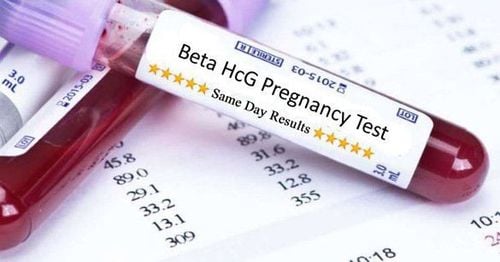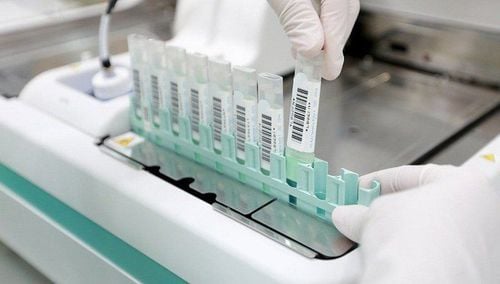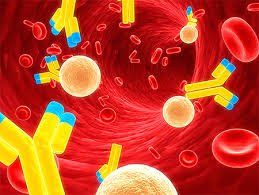This is an automatically translated article.
Article written by Doctor Le Duy Cuong - Laboratory Department - Vinmec Times City International General Hospital1. Scope of application
Determination of IgA and IgG group antibodies against 2 types of tissue transglutaminase antigens (tTG) and gliadin (GAF-3X) (gliadin-analogue fusion peptide) in serum or plasma for the diagnosis of gluten intolerance (disease) Coeliac) and Duhring bullous skin disease. The identification of group A (IgA) and G (IgG) antibodies in the case of IgA deficiency plays a very important role.
Serological testing for disease-specific antibodies to endomysium and gliadin (IgA and IgG) is essential for the diagnosis of gluten intolerance (coeliac disease, dysentery Sprue) and it It is also suitable for assessing the stage of the disease as well as the effectiveness of treatment.
2. Epidemiology of Coeliac disease
Coeliac disease is an inherited systemic autoimmune disease that manifests in the individual as a response to gluten intake. Gluten is found in many grains (e.g., wheat, barley, rye, etc.). The most important protein causing celiac disease is gliadin.

3. Pathogenesis of Coeliac
Coeliac disease is caused by both genetic and environmental factors. Gliadin in food is only partially digested in the intestine. In patients with celiac disease, the remainder of the gliadin peptides can cross the lining epithelium of the small intestine and enter the underlying connective tissue layer. Here, protein fragments are removed by the enzyme tissue transglutaminase (tTG). In this process, the amino acid glutamine is converted to glutamic acid. If human leukocyte antigens (HLA)-DQ2 or DQ8 are present, these peptides activate the immune system by antigen-presenting cells. As a result, proinflammatory cytokines are released, gliadin-specific antibodies and autologous tTG enzymes are produced. This immune response leads to inflammation and destruction of the small intestinal mucosa, which histologically characterized by a villous atrophy and hyperplasia of intestinal cysts. Marsh classification is divided into 3 groups of celiac disease according to severity on histopathology of the intestine:
Marsh type I: increased endothelial lymphocytes (> 40 IEL/100 epithelial cells) with normal mucosal structure normal
Marsh type II: increased cysts with normal epithelial structure
Marsh type III: increased endothelial lymphocytes, cystic hyperplasia, destruction of epithelial cells and epithelial atrophy. Type III can be divided into Marsh IIIA (partial epithelial atrophy), Marsh IIIB (large epithelial atrophy) and Marsh IIIC (complete epithelial atrophy).

4. Significance of Coeliac IgA and IgG profiles against tTG & GAF-3X
Serological diagnosis is an economical and noninvasive method for the diagnosis and monitoring of celiac disease. In cases of high anti-tTG IgA can help confirm the diagnosis without the need for small bowel biopsy.
Specific IgA antibodies against tTG or endomysium are considered to be the most sensitive and specific markers for celiac disease. As part of the use of Anti-Gliadin (GAF-3X) ELISA (IgA, IgG), antigen using GAF-3X is available as a specific antigen (antigen dots) for the IIFT test in a BIOCHIP result (EUROPLUS) with tissue sections, and in the EUROLINE Coeliac disease test kit.
HLA typing is another important part of the diagnosis of celiac disease, especially in cases of equivocal biopsies, equivocal serological results, or asymptomatic but high-risk patients. With a negative diagnostic value from risk factors for HLA-DQ2 and DQ8 of at least 98%, celiac disease can be largely ruled out if no allele is detected in the patient.
Antigen-antibody reactions also provide useful information for monitoring gluten diets. A decrease in antibody titers indicates that treatment is effective and is often accompanied by improvement in clinical symptoms.
Profile Coeliac IgA and IgG is a combination of two autoantibodies against tTG and GAF-3X that increases diagnostic accuracy. Patients with IgA deficiency (low total IgA levels will cause false negatives for anti-tTG and anti-GAF-3X IgA) should not be missed by additional IgG testing. The use of GAF-3X antigen results in a higher sensitivity for diagnosis in children < 2 years of age.
If you have a need for consultation and examination at Vinmec Hospitals under the nationwide health system, please book an appointment on the website for service.
Please dial HOTLINE for more information or register for an appointment HERE. Download MyVinmec app to make appointments faster and to manage your bookings easily.














